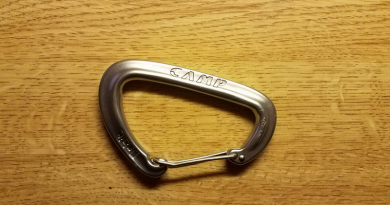Those starting their rock climbing careers know one thing:
Using the right chalk can greatly enhance your climb. But choosing the right chalk can be complicated—especially if you don’t know the differences between each. That’s why I’ve put together a comprehensive guide that breaks down a common rock climbing question: should you choose liquid chalk or dry chalk?
Join me below as I walk through everything you need to know about these two popular types of chalk. In doing so, you can better understand the type of chalk right for you.

What Is Liquid Chalk?
First, let’s start by answering the easy questions—such as, what is liquid chalk?
Unlike other forms of chalk, this popular variation comes in a liquid form that is typically squeezed and lathered onto hands.
Liquid chalk may be bought from stores or made from home for those who know how. Those looking for a great liquid chalk recipe can check out my “how to make liquid chalk” guide here.
What is Dry Chalk?
Dry chalk, on the other hand, doesn’t come in a liquid form.
Though, my guess is that you already knew that based on its name.
Instead, dry chalk comes in a powder form that can be dusted over your hands. You can buy dry chalk commercially.
With that in mind, let’s take a closer look at these two chalk forms. How do they differ? Is one of them better than the other?
Consider the following information below to answer those questions.
How Do Liquid and Dry Chalk Differ?
People use both liquid and dry chalk for the same basic reason: they’re looking to get a better grip.
By using chalk, many find that their grips improve while climbing. Not only does this enable them to make harder or more daring climbs, but it makes it safer to do so, as well.
However, despite the fact that they have a nearly-identical goal, the two couldn’t be more different in some regards.
Understanding the differences between liquid and dry chalk allows one to better choose the chalk best suited for him.
So what are some of the differences between liquid and dry chalk? Let’s take a look below:
- Their Composition
Alright, I know this one’s obvious, but it’s worth mentioning.
The two forms of chalk differ most in their makeup. Obviously, one is a powder and the other a liquid. And though you didn’t really need me to point that out for you, I do so because this difference causes many of the others on this list.
- Ease of Distribution
For example, the nature of liquid chalk makes it easier for many to apply.
Because of its liquid form, liquid chalk typically doesn’t take as long to apply—and it’s easier to get an even coat.
All this proves vital when you’re hanging in the air while making your climb. Trust me: you will find that your grip is slipping sometimes. They’ll be times when you start sweating so much that you’re going to need something to dry your hands out.
And you’ll need it fast.
While in the middle of a climb, you’ll struggle to roll a ball of dry chalk around your hands. You’ll struggle even more to make sure that they’re evenly coated.
For this reason, liquid chalk often proves a superior choice for certain individuals.
- Durability
What’s more, many find that liquid chalk simply lasts longer.
This means that it provides greater protection against sweating and other moisture than does dry chalk.
Rock climbers looking to make long climbs often find this great—but you’ll need to be careful not to overdo it. Because liquid chalk can last so long, you’ll need to make sure that you’re not over-drying your hands.
- Quickness
Need to dry your hands quickly?
Liquid chalk should be your go-to. Because it contains rubbing alcohol, it works to quickly dry out any moisture in your hands.
In turn, you’ll start enjoying a better grip in no time.
That being said, liquid chalk does have its downsides—especially for those with sensitive skin.
Join me as I take a closer look at liquid chalk and while I address some of its pitfalls.
Why Do People Use Liquid Chalk?
As you can see from above, liquid chalk attracts many climbers for a variety of reasons. Due to its fast-acting nature, liquid chalk has won over the hearts of climbers looking to start their climbs quickly.
Additionally, because they find it easy to distribute, many climbers prefer using liquid chalk as a way to evenly coat their hands.
When Do You Use Liquid Chalk?
Climbers tend to use liquid chalk over dry chalk in certain situations.
Namely, many climbers prefer liquid chalk when doing longer climbs. Because liquid chalk lasts longer, climbers won’t have to redo their hands as often when using it. This makes it a popular choice because—trust me—climbers don’t like having to stop mid-climb to reapply chalk.
Climbers who have excessively sweaty hands may also prefer to use liquid chalk. Because of its alcohol content, it provides enormous drying power, helping even those with the sweatiest of palms perfect their grips.
Does One Type of Chalk Dry Out Your Skin More?
With that in mind, however, remember that liquid chalk isn’t perfect.
In fact, many climbers complain that liquid chalk excessively dries out their skin. Though this may be good for rock climbing, it’s a detriment in their daily lives.
Because liquid chalk contains alcohol, it can severely dry out your skin. In order to combat this, many climbers use a mixture of liquid and dry chalk. By doing so, they enjoy the benefits of using liquid chalk while minimizing the risks.
No matter what you do, consider supplementing your daily hygiene regime with hand lotion for days when you’re not climbing. This can help protect your skin in the long run.
Keep in this information in mind as you look to choose the chalk right for you.






